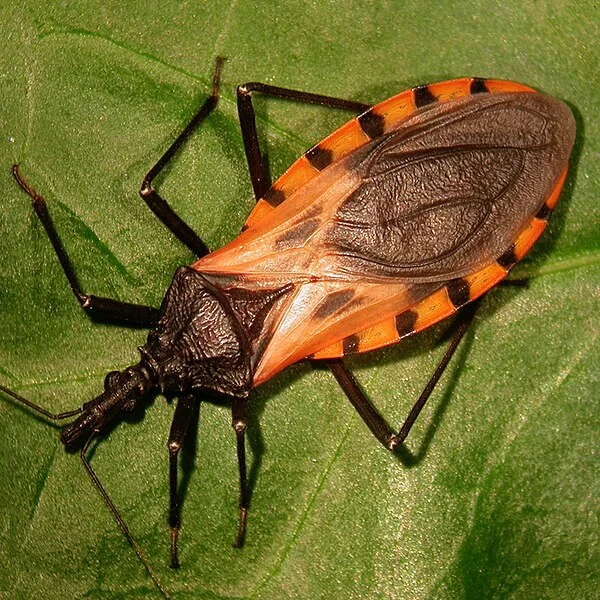When Emiliana Rodríguez was a child, she witnessed friends playing soccer late at night when one of them unexpectedly passed out on the pitch. Unaware of what had happened, the native Bolivian Rodríguez became afraid of the dark and the quiet killer Chagas, the “monster” that, she was told, only comes out after dusk.
A unique form of critter, Chagas is a “silent and hushed illness,” spread by nocturnal insects that can infect up to 8 million people annually, of which Rodríguez’s acquaintance is one of the 12,000 victims.
Emiliana Rodríguez, 42, moved to Barcelona 27 years ago from Bolivia and realized she would never be able to escape Chagas, a “monster,” as she puts it.
“Nighttime is when the worry generally struck. I had trouble falling asleep sometimes,” she said. “I was worried that I would nod off and not wake up.”
Eight years ago, during her first pregnancy, Rodríguez had some tests done, which revealed she carried the Chagas gene. “I was astounded and remembered all those stories my family told about people dying suddenly,” she said, recalling her friend’s death. “I wondered, ‘What will become of my baby?'”

Nonetheless, Rodríguez underwent therapy to stop the parasite from vertically transmitting to her fetus. After her daughter was born, she did not test positive.
Meanwhile, Elvira Idalia Hernández Cuevas, a Mexican, had never heard of Chagas until her 18-year-old son was identified as having the silent killer.
Idalia, an eighteen-year-old blood donor, was giving blood in her hometown of Veracruz, Mexico, when her sample was examined. This led to a positive diagnosis of Chagas, a disease brought on by a bloodsucking parasite known as triatomine bugs, sometimes known as kissing or vampire bugs.
In an interview with the Guardian, Hernández said, “I started researching it on the internet because I had never heard of Chagas.” When I saw that it was described as a silent assassin, I became really afraid. I had no idea where to go or what to do.
She is not alone; many people are unaware of the vectorborne illness brought on by these bothersome pests.
Carlos Ribeiro Justiniano Chagas, a Brazilian physician and researcher who discovered the human case in 1909, is the inspiration behind the name Chagas. It has been recognized for several decades that Chagas disease is common in Australia, Japan, Europe, North America, and Latin America.

The majority of kissing bugs in rural or suburban areas live in the walls of low-income homes, and they are most active at night while people are sleeping. The insect bites an animal or person, then excretes on the skin of the victim, who may unintentionally scratch the region and break the skin, or who may transport the excrement into their mouth or eyes. This is how the T. cruzi infection is spread.
According to the World Health Organization (WHO), between 6 and 7 million people worldwide—roughly 8 million people in Mexico, Central America, and South America—have Chagas disease; most of these people are unaware that they are infected. The permanent infection might be lethal if untreated. Every year, about 12,000 people pass away from Chagas disease, which the Guardian claims kills “more people in Latin America than any other parasite ailment, including malaria.”
Even though about 300,000 people in the United States have been recognized as afflicted with these bugs, they are not thought to be endemic.
While some people never show symptoms, the CDC notes that after decades, 20 to 30 percent experience heart issues, which can result in mortality, or gastrointestinal disorders, which can cause excruciating pain.
In addition, only 10% of cases worldwide are detected globally, making prevention and treatment extremely difficult.

Hernández and her daughter Idalia sought help from a number of medical professionals who had little to no information about Chagas disease or how to treat it. I was taken aback, scared, and upset because I thought my kid was going to die. Most importantly, I was unable to find any trustworthy information, which increased my level of concern,” Hernández said.
Idalia eventually got the necessary treatment after receiving support from a family member working in the medical field.
According to Hernández, “the authorities in Mexico assert that the Chagas disease is under control and that there are not many infected individuals, but that is not the reality.” “Medical practitioners misdiagnose Chagas disease for other cardiac problems because they lack training in this area. Most people are ignorant that there is a Chagas disease in Mexico.
The World Health Organization (WHO) has labeled Chagas as a neglected tropical disease, meaning that the global health policy agenda is not giving it any attention.
Treatment for Chagas disease
Drugs for Neglected Diseases Initiative (DNDi) research manager Colin Forsyth explained that one reason Chagas is overlooked is that it is a silent illness that stays hidden in your body for a long time since the early stages of the infection do not create any symptoms.
Forsyth continued, citing the underprivileged populations, saying, “The affected people just do not have the power to change healthcare policy. It is hidden because of the combination of social and biological issues.
Chagas, however, is becoming more well-known as it spreads to other continents and is now known to be spread by organ and blood transfusions, as well as from mother to child during pregnancy and childbirth.
The main goals of the UK-based Chagas Hub, according to Professor David Moore, a doctor at the Hospital for Tropical Diseases in London, are to “get more individuals diagnosed and treated, and to manage the risk of transmission, which in the UK is from mother to child.”
Regarding the WHO target of a 2030 illness elimination, Moore expressed that the current level of Chagas disease eradication is “glacial,” adding, “I can not fathom that we will be anywhere close by 2030.” That seems incredibly unlikely.
Two drugs that have been on the market for more than 50 years—benznidazole and nifurtimox—can be used to treat chagas. Moore characterizes these drugs as “toxic, unpleasant, and not very effective.”
While it can heal a baby, there is no guarantee that the drugs would stop or slow the spread of the illness in an adult.

When it came to severe side effects, Rodríguez remembers getting hives, dizziness, and nausea. She had a satisfactory outcome from her treatment and now gets annual physicals.
Moore stresses that developing more potent Chagas treatment is essential to halting the disease’s spread, but pharmaceutical companies are currently not financially motivated to make this investment.
Hernández, who serves as president of the International Federation of Associations of People Affected by Chagas Disease (FINDECHAGAS), is working to give the disease a more prominent voice until there is a stronger market need for new treatments.
What should I do in the event that I find a triatomine bug?
Rodríguez, meanwhile, is fighting the “monster” in Spain by raising awareness of Chagas disease through an initiative run by the Barcelona Institute for Global Health.
“I am tired of the general quietness,” declares Rodríguez. “I want people to talk about Chagas and to be educated about it. People should be tested and treated, in my opinion.
Also, their messages are having an impact.
World Chagas Disease Day was established by the WHO and is observed on April 14, the day that Carlos found the first human case in 1909. As per the WHO, “a broad array of 20 illnesses and disease categories are to be prevented, controlled, eliminated, and eradicated by 2030, with milestones set.” That includes Chagas.
In order to prevent possible infestation, the CDC advises you to:
- Caulk gaps and openings surrounding doors, windows, walls, and roofs.
- Get rid of any piles of wood, brush, and stones close to your home.
- Use screens on windows and doors, and patch up any tears or holes.
- Seal cracks and gaps that lead to the crawl spaces beneath the house, the attic, and the outdoors
- Allow your pets to sleep indoors, especially at night.
- Keep your home and any outdoor pet rest spots tidy, and periodically check both for the presence of bugs.
The CDC advises against squashing kissing bugs that you come across. Rather, you should carefully put the bug in a container, add rubbing alcohol to it, or freeze it in water.
It is therefore advised that you take the container containing the insect to a university laboratory or your local health authority for identification.
The idea that these bugs live in residential walls is really unsettling; it is like those terrifying stories you heard as a kid about being wary of the monster living behind the walls.
We genuinely hope that the WHO follows through on its promise to end Chagas disease and other neglected tropical illnesses.
H/T : blog.browsefeed.net



